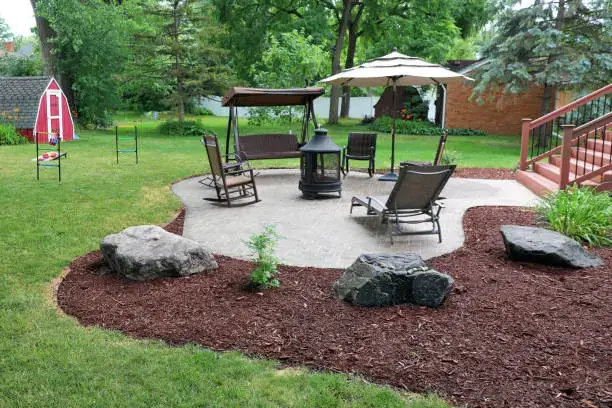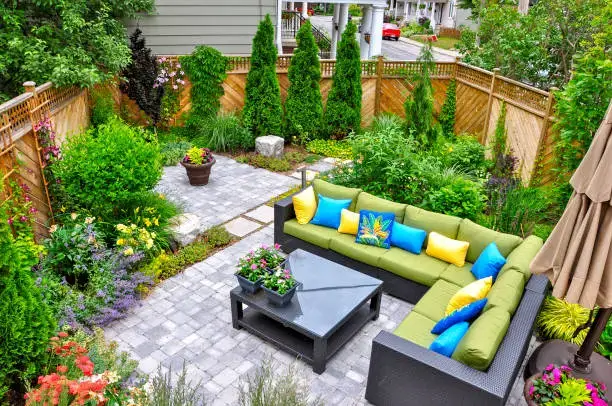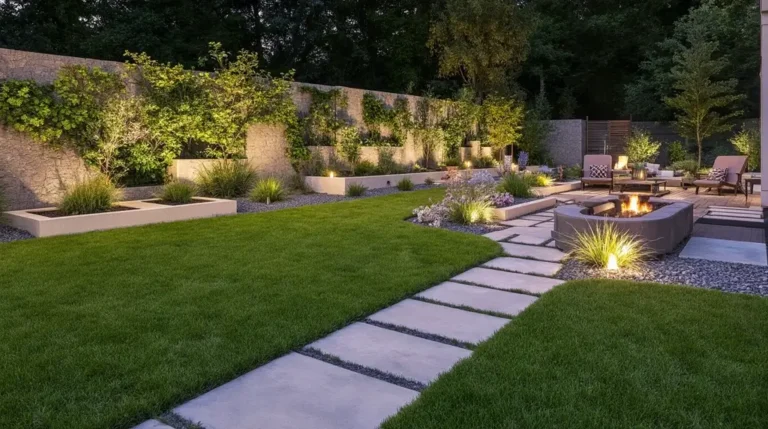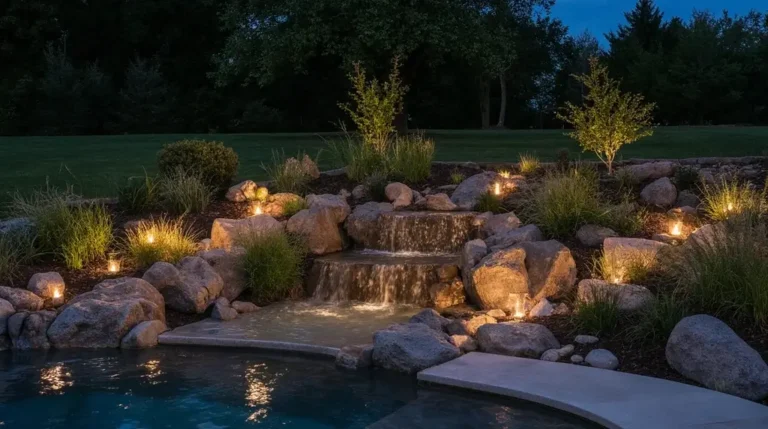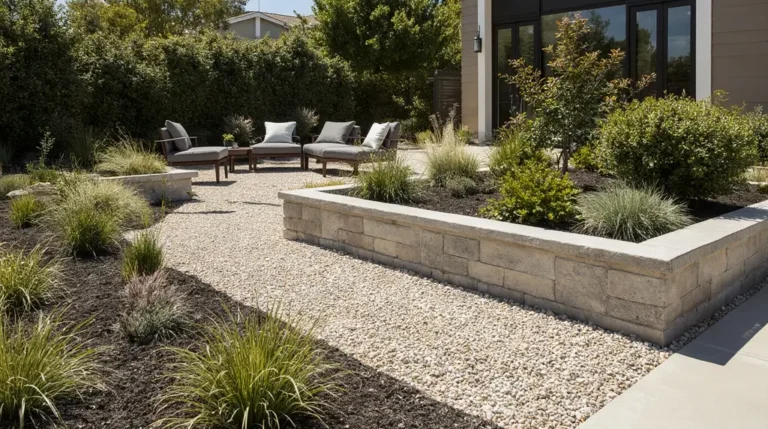Front Yard Landscaping Ideas to Boost Your Home’s Curb now
Table of Contents
Introduction: Redefining Your Home’s First Impression in 2025
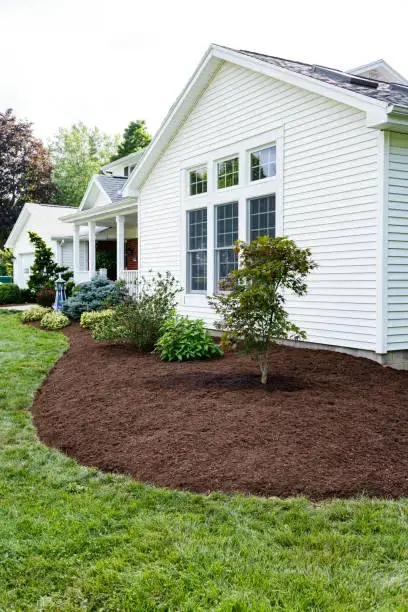
Your front yard is more than just a space; it’s the gateway to your home and a reflection of your lifestyle. In an era where first impressions matter more than ever, front yard landscaping has evolved from simple grass-and-shrub combinations to sophisticated outdoor environments that tell your story while boosting property value. 👉 Complete your dream garden with our handpicked Garden Design & Landscaping essentials that make outdoor spaces stylish and practical.
Why does 2025 matter for front yard landscaping trends ideas? Today’s homeowners face unique challenges and opportunities driven by environmental awareness, technological advances, and a growing desire for personalized outdoor spaces. Rising temperatures demand climate-adaptive solutions, while busy lifestyles require low-maintenance designs that don’t sacrifice beauty for practicality.
This comprehensive guide offers everything you need to create a stunning front yard transformation. We’ll explore cutting-edge trends, share practical garden design ideas, provide realistic budgeting insights, and show you how to achieve an eco-friendly landscape that enhances your home’s curb appeal while reflecting your personal style.
Foundational Principles for Modern Front Yard Landscaping
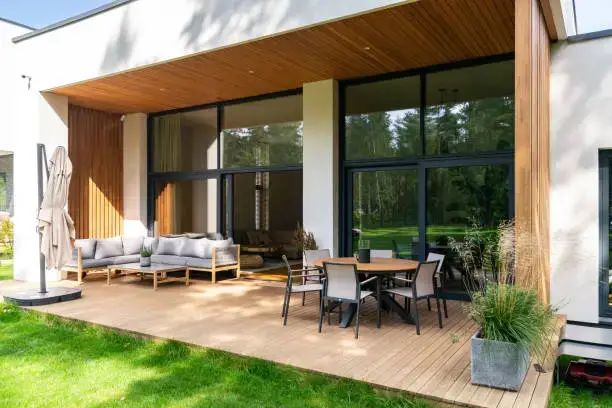
Embracing Sustainability as a Standard
Sustainable landscaping has evolved from trend to necessity in 2025. Modern front yard landscaping ideas prioritize environmental responsibility through native plant selection, water conservation, reduced chemical inputs, and long-term ecological thinking. This approach not only benefits the environment but creates resilient landscapes that require less maintenance and resources over time.
The Demand for Low-Maintenance Designs
Today’s homeowners need gardens that offer maximum impact with minimal upkeep. Smart garden design ideas focus on selecting hardy, resilient plants, implementing efficient irrigation systems, utilizing strategic mulching, and incorporating thoughtful hardscaping elements that reduce maintenance while enhancing visual appeal.
Creating Year-Round Interest
A successful front yard landscape maintains engagement through all seasons. This requires careful planning with diverse plant textures, sequential blooming schedules, evergreen structure plants, and hardscaping elements that provide visual interest when plants are dormant.
Harmonizing with Your Home’s Aesthetic
The best front yard landscaping seamlessly integrates with your home’s architectural style, local climate conditions, and personal preferences. Whether your home is contemporary, traditional, or somewhere in between, your landscape should feel like a natural extension of your living space.
Top 2025 Front Yard Landscaping Trends & Inspiring Ideas
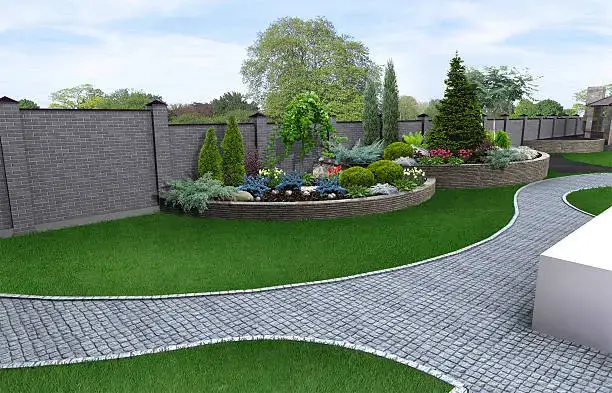
Suburban Micro-Forests & Urban Rewilding
One of the most exciting trends in modern landscaping involves creating micro-forest environments by planting dense clusters of native trees and shrubs. These intimate ecosystems increase biodiversity, combat urban heat islands, improve air quality, and provide natural cooling. Even small front yards can incorporate this concept through strategic groupings of native species that create layered, forest-like environments.
Expanding the Tree Canopy for Shade & Cooling
As temperatures rise, shade trees have become essential elements in front yard landscaping ideas. Large canopy trees like elms, sycamores, and regional natives provide natural cooling, reduce energy costs, and create comfortable outdoor spaces. Strategic tree placement can significantly impact your home’s microclimate while adding substantial property value.
Outdoor Wellness & Hobby Happiness Spaces
Modern front yards increasingly reflect personal interests and lifestyle priorities. Homeowners are creating dedicated spaces for outdoor yoga, meditation gardens, compact vegetable plots, fire pit gathering areas, and even outdoor kitchen elements. These personalized landscapes transform functional spaces into extensions of indoor living areas.
Vertical Gardens & Green Walls
Space-saving vertical gardening solutions maximize impact in compact areas while providing privacy and visual interest. Trellises with flowering vines, pergolas supporting climbing plants, and innovative plant wall installations bring color and texture to previously unused vertical spaces.
Native Wildlife & Pollinator Gardens
Creating habitats for birds, bees, and butterflies has become a priority for environmentally conscious homeowners. Pollinator-friendly plant selections, strategically placed birdhouses, shallow water features, and butterfly puddling stations transform front yards into thriving ecosystems that support local wildlife while providing natural beauty.
Edible Landscaping
The boundaries between ornamental and functional gardens continue to blur in 2025. Herb borders featuring rosemary, thyme, and lavender provide beauty and utility. Dwarf fruit trees, espaliered varieties trained against walls or fences, and compact vegetable gardens integrate food production into attractive landscape designs.
Art & Sculpture in the Garden
Strategic placement of weather-resistant sculptures, artistic water features, or handcrafted elements creates compelling focal points that reflect personal style. Materials like stone, weathering steel, and bronze age gracefully while providing year-round visual interest.
Essential Elements for a Functional & Beautiful Front Yard
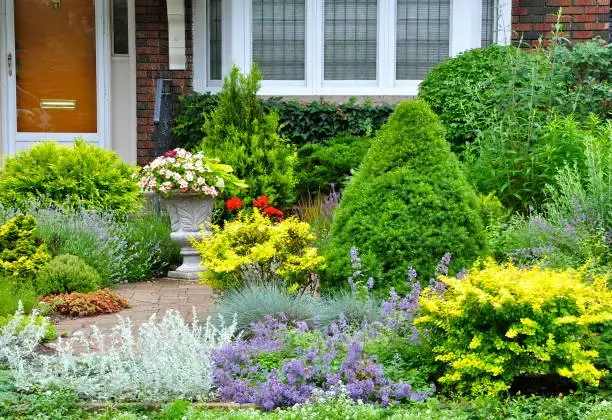
Thoughtful Plant Selection
Native plants form the backbone of sustainable front yard landscapes. These species require less water, resist local pests naturally, and support regional wildlife. Examples include serviceberry and ninebark in northern regions, while southern areas might feature native grasses and drought-tolerant perennials.
Drought-tolerant species like ornamental grasses, succulents, jasmine, and rosemary provide structure and beauty while conserving water. Foundation plants such as boxwood, hydrangea, and evergreen shrubs create year-round structure.
Layered planting combines different heights, textures, and bloom times for cohesive, dynamic displays. Consider incorporating trees like maples, dogwoods, and redbuds with understory shrubs and perennial groundcovers for complete ecosystem designs.
Strategic Hardscaping Elements
Well-planned hardscaping provides structure and reduces maintenance requirements. Walkways and pathways using natural stone, brick, or permeable pavers create attractive, functional access routes. Curved designs feel more natural than straight lines, while integrated lighting enhances safety and ambiance.
Driveways using stamped concrete or interlocking pavers add character while managing water runoff. Retaining walls help manage slopes while creating planting opportunities and defining spaces.
Ground cover alternatives to traditional turf include clover, creeping thyme, sedum, or decorative rock gardens that require minimal maintenance while providing unique textures and colors.
Strategic mulching using organic materials like wood chips provides nutrients and moisture retention, while inorganic options like decorative gravel offer longevity and weed suppression.
Water Features for Tranquility & Sustainability
Modern water features emphasize sustainability through recirculating systems, rain gardens that manage stormwater runoff, and solar-powered fountains. These elements provide soothing sounds, attract wildlife, and create focal points while supporting environmental goals.
Outdoor Lighting
Strategic lighting enhances safety, highlights landscape features, and extends outdoor enjoyment into evening hours. LED fixtures, solar-powered options, and automated systems provide efficient, attractive illumination that complements your garden design ideas.
Budgeting & Planning Your Front Yard Transformation
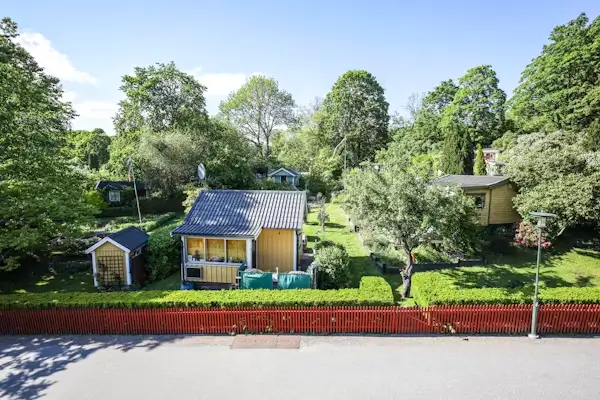
Setting a Realistic Budget
Successful landscaping projects begin with honest financial assessment and clear priority setting. Focus on needs versus wants, and consider phasing larger projects over multiple seasons to spread costs while achieving immediate improvements.
Cost Breakdown
Understanding typical costs helps with realistic planning:
- Pathways/Walkways: $15-$30 per square foot
- Driveways: $50-$100 per square foot
- Patios/Sitting Areas: $20-$50 per square foot
- Water Features: $1,000-$10,000+
- Retaining Walls: $30-$50 per square foot
- Outdoor Lighting: $50-$150 per fixture
- Professional Labor: $50-$100 per hour
- Annual Maintenance: 5%-10% of total project cost
DIY vs. Professional Help
Many elements of front yard landscaping work well as DIY projects, including planting, mulching, and simple hardscape installation. However, complex designs, major grading work, irrigation systems, and electrical components often require professional expertise for safety and optimal results.
Budget-Friendly Strategies
Phased implementation allows you to spread costs while enjoying immediate improvements. Smart material choices, comparison shopping, and focusing on high-impact elements first maximize your investment. Sometimes less truly is more—minimalist designs using native plants, strategic hardscaping, and quality mulching can create stunning results within modest budgets.
Special Considerations: Small Front Yards
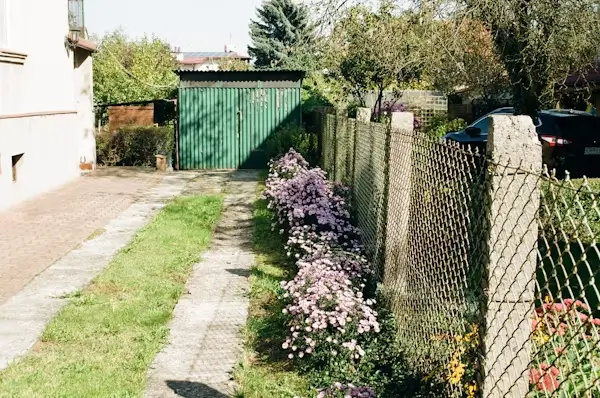
Maximizing Curb Appeal in Compact Spaces
Small front yards require strategic thinking to maximize impact. Focus on quality over quantity, choose plants that provide multiple seasons of interest, and use vertical space effectively.
Top Ideas for Small Yards
Native grasses provide movement and texture while requiring minimal maintenance. Container gardens offer flexibility and seasonal color changes. Sculpted shrubs create structure and modern appeal.
Decorative water features serve as focal points without overwhelming small spaces. Strategic walkway plantings soften hardscape edges while guiding visitors naturally.
Minimalist landscaping emphasizes clean lines, quality materials, and carefully selected plants that provide maximum impact. Vertical gardening adds color and privacy while utilizing previously unused space.
Design Principles for Small Spaces
Creating focal points becomes crucial in compact areas—one strong element often works better than multiple competing features. Clean lines, strategic use of color, and careful scale selection prevent small spaces from feeling cluttered while maintaining visual interest.
The Role of Smart Technology in Your 2025 Front Yard
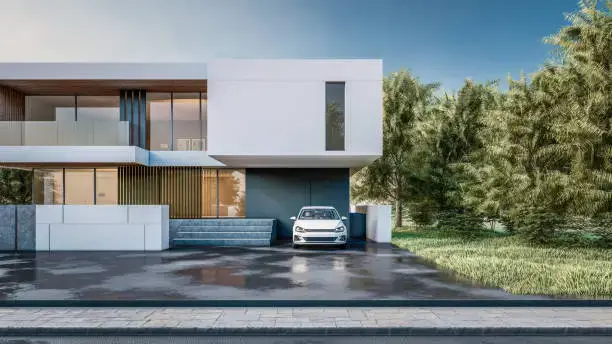
Smart Irrigation Systems
Modern irrigation technology includes moisture sensors, weather-responsive controllers, and efficient drip systems that reduce water waste while maintaining plant health. These systems can reduce water usage by 30-50% while ensuring optimal plant care.
Automated Lighting
Smart lighting systems provide security, highlight landscape features, and create ambiance while operating efficiently through programmable controls and LED technology.
Future Advancements
Emerging technologies include AI-assisted garden planning, robotic maintenance equipment, smart plant sensors, and integrated weather monitoring systems that will continue transforming landscape management.
Ongoing Maintenance for Lasting Beauty
Successful front yard landscaping ideas include realistic maintenance planning. Seasonal care schedules, efficient watering systems, strategic mulching, and proper plant selection create landscapes that remain beautiful while requiring reasonable maintenance commitments.
Regular mulch refresh, seasonal pruning, and integrated pest management using environmentally responsible methods maintain landscape health while supporting sustainability goals.
Conclusion: Your Dream Front Yard Awaits
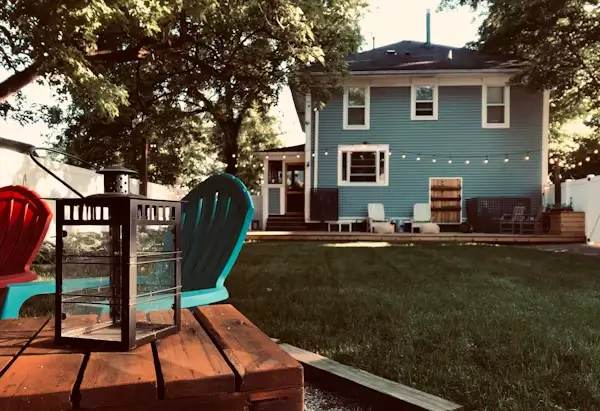
The perfect blend of aesthetics, sustainability, and practicality defines outstanding front yard landscaping in 2025. Whether you’re drawn to micro-forest environments, edible landscapes, or minimalist designs, today’s garden design ideas offer endless possibilities for creating outdoor spaces that reflect your values and lifestyle.
Your front yard transformation begins with vision, planning, and commitment to creating spaces that enhance both your daily life and property value. Start by assessing your site conditions, defining your priorities, and exploring local plant options that thrive in your specific environment.
The tools, inspiration, and knowledge you need are readily available. Begin planning your project today, consult with local nurseries about native plant options, and consider professional consultation for complex elements. Your dream front yard—one that welcomes guests, supports local wildlife, and reflects your personal style—awaits your creative vision and thoughtful planning.
Front Yard Landscaping Ideas to Boost Your Home’s Curb now
Your front yard is more than just a space; it’s the gateway to your home and a reflection of your lifestyle. In an era where first impressions matter more than ever, front yard landscaping has evolved from simple grass-and-shrub combinations to sophisticated outdoor environments that tell your story while boosting property value. 👉 Complete your dream garden with our handpicked Garden Design & Landscaping essentials that make outdoor spaces stylish and practical.
Why does 2025 matter for front yard landscaping trends ideas? Today’s homeowners face unique challenges and opportunities driven by environmental awareness, technological advances, and a growing desire for personalized outdoor spaces. Rising temperatures demand climate-adaptive solutions, while busy lifestyles require low-maintenance designs that don’t sacrifice beauty for practicality.

